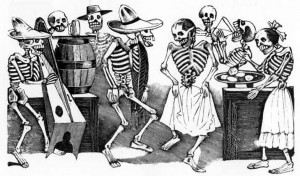I have been away for a long time. But nothing seems to have changed so much or has it? I always think like that when I come home after a stretch of time away from the daily routines. Sometimes every day life does not seem to fulfill the hope in the future, it may even seem monotonous, an avoidance of thinking in a better world. If you think like that, you may wonder what has happened in world history: were the lives of people same as mine hundreds of years ago? Has there not been any changes evolving from daily life?
Amongst the things that seem to have changed, the myriad of little things that move without us noticing them, I found a couple of events that renewed my expectations in the change that is to come. These two findings refer to the ways in which we look at the others (and by reflection, the way we look at ourselves).
Some weeks ago, while preparing the last exhibition I made, which dealt with the obsession with the death in the work of Mexican master artist José Guadalupe Posada, I found myself trying to understand the times he lived in. A century ago Posada was the eye that saw for the many: the artist who looked around him into the daily lives of his peers and fellow countryman, to the folk on the street.
Posada lived and worked amidst the first revolution of the 20th century, the Mexican Revolution. During his daily life, working from a small print shop in downtown Mexico City, he used to draw eight to 10 plates a day. These plates recorded the lives and dreams of the many but also the private lives of the few. Posada filled the gaps in the imagination. These gaps exist between our life and the endless possibilities of living.
In his lifetime Posada draw more than 20 thousand images with his own hands. Sometimes inventing stories and characters, as the famous lady of the death, La Catrina; a cartoon that represents a radical departure from the European Vanitas paintings (whose theme is the vanity of a monotonous life), which transforms dead from as something static and anti esthetic into a living caricature of dead. In Posada’s hands death became a paramount image of life.
And while he was transforming daily life into a promise of the future, by making us imagine the endless possibilities of death (both, within life and after life), Posada became a chronicler of the world around him. When you realize this, you may think about the powers of the artist, the secret potential that his art is bestowed with. Then you slowly realize that death is not to be feared or avoided, because it is part of life and it fits perfectly in existence. We want to die and be born again in the imagination.
After the opening of the exhibition of Posada’s prints in Rotterdam, I read on the paper that 35 thousand people flooded the British Museum to attend the opening of the Mexican Day of the Dead festivities last November 1st. A date when people all over Mexico celebrate they deceased by visiting the graveyards and staging altars in their homes ( at the center of their daily lives) devoted to them. There is no sadness there but a exhilarant celebration of the coming of the death to their homes.
When I learned so many people visited the British Museum in only one day, I stopped to wonder. What is it that makes dead such a popular subject in postindustrial Britain? Perhaps the exhibition and performance attracted many Britons because our economic system has rendered life into a mimic, fearing pain and death, which are both part of life; or perhaps because our lives have become dull and empty, where the capitalist offer of consumption cannot fulfill our desire to transcend.
November is the most significant time of the year for Mexicans because it is the period when they concentrate, by means of ritual, in that which is hold dear to them, on that which makes them feel a sense of community with their peers and with those who are no longer here but remain present by means of invocations.
By virtue of the legacy of one man, Posada, this tradition has become available to other cultures. And thus it has come to seize the attention of other cultures, where the need for change and transcendence is weakening.
No culture can remain isolated or unchanged by the ravages of time. And when a culture needs that of change is not coming from within it is from abroad that it looks for an answer. Mexicans have become masters of that swaying movement, from within to outside, in search of themselves and in need of understanding the diversity of existence.
The first collector was a dead human, buried within his precious jewels and daily objects. The meaning of his or her life was buried with him/her in order to facilitate his journey into the far beyond. The objects he wore and became attached are tools of memory, the means to find the way back to his people, as the indigenous traditions believed it should be.
When thinking about jewelry, as transitional objects that help us communicate and remember, do we think of dead as the end or just as a new stage?
Watch the l the event at the British Museum at:



